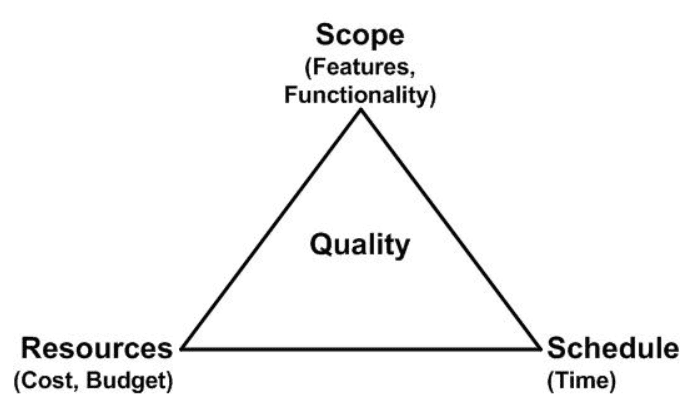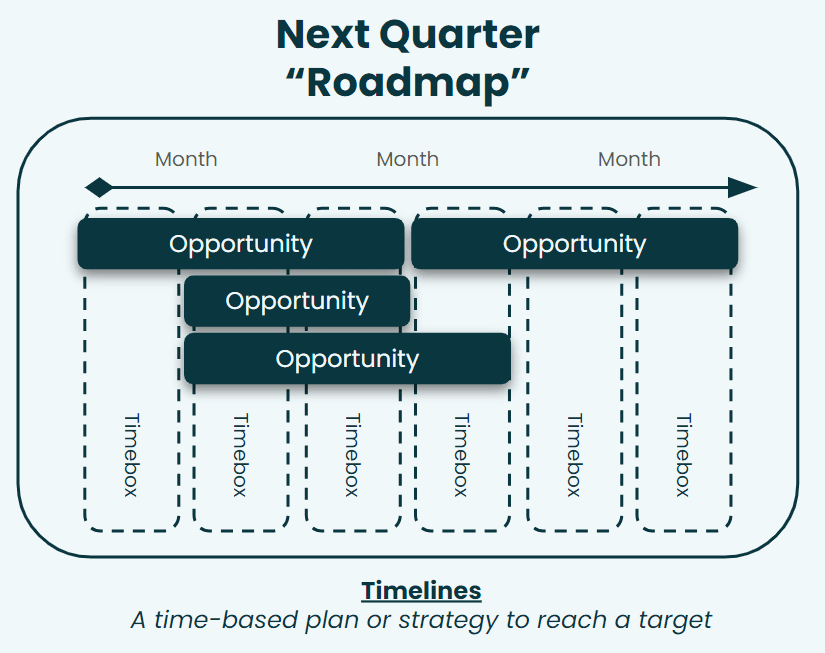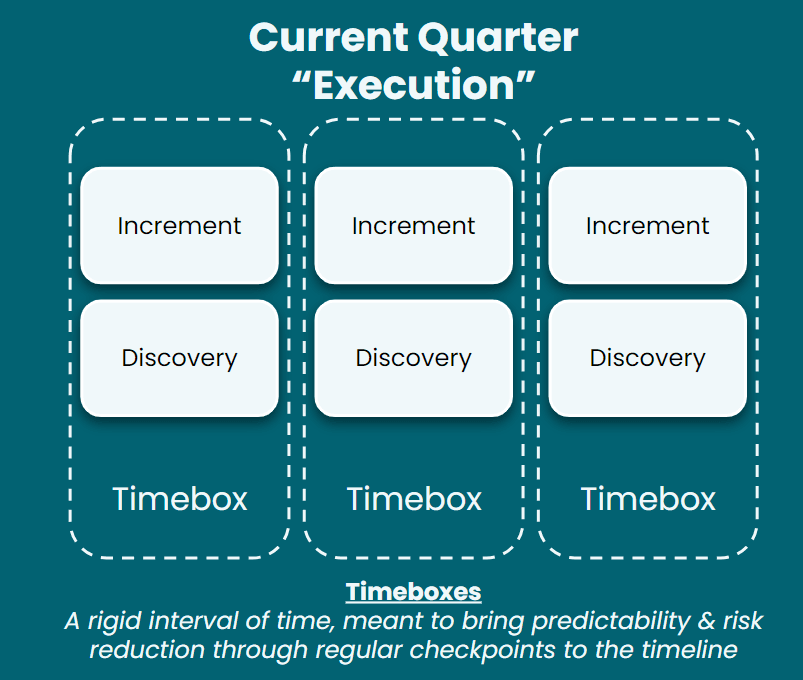How Our Product & Engineering Teams Plan Ahead at Dashlane

Planning the work of Product & Engineering teams is always complicated. There are as many ways of doing it as there are companies, and it depends on culture, history, leadership styles, and the type of product.
On one hand, you want enough predictability so the organization can operate with some level of consistency and anticipation. On the other hand, you don’t want to go overboard estimating ahead and getting into false precision—when the act of planning takes more time than actually getting things done.
Let’s start by talking about notions of time, which is at the heart of planning.
Notions of time
Time is a key component to any business, particularly for startups and companies that aren’t yet profitable. It’s a limited resource and a constraint in product development. It’s a concept that can benefit or harm you, depending on how you use it. Winning in a competitive market is, after all, a race. However, time is not a fixed and unique concept. Its meaning and understanding vary a lot, and there’s such a thing as the elasticity of time.
The different realities of time
In the triangle of project management, time usually appears as one of the constraints.

Software development projects are challenging because you need to find the right balance between:
- Scope: What must be built
- Schedule: When it must be built by (the time constraint)
- Resources: How much it costs
In the center is quality, which is a constraint because you should only want to ship work that has the appropriate level of quality.
Layers of deadlines
At a company level, you need to factor in different types of deadlines and milestones. For example:
- Budget milestones: You make assumptions about when things will happen to model your revenues (like delivery of new features that will generate revenue) and expenses (like when a new hire will join).
- Marketing moments: To highlight a new product improvement to journalists or coordinate a campaign, you need to identify dates. They must be fixed dates since they involve third parties and advanced planning and coordination.
- Regulatory compliance: You may need to comply with external regulations, such as SOC2 renewal.
- Internal team deadlines: This is related to the roadmap defined by a team and when they expect to deliver changes to the product. Communication and alignment with team stakeholders are critical here.
Roadmaps and timelines
In any activity related to delivery, it’s good to estimate how long activities will take and organize the different steps through a roadmap, timeline, or project plan.
Roadmaps help the team sequence the effort and understand when they expect to ship key deliveries. It gives a sense of accountability and helps coordinate and communicate across the organization.
Estimating work is a complicated exercise, so you need to be aware of the exercise’s limits. Adapt the precision and time spent using estimates depending on the level of unknowns in the project. Start with high-level estimates and roadmaps at first (t-shirt sizing is enough at this stage). Then, as you progress, use finer and more precise estimates and roadmaps.
You want to work in small increments because it reduces risk, generates value sooner and faster, and makes it easier to build roadmaps without estimating too much ahead of time with false precision.
Using time as a positive driving force
We often see time as a constraint imposed on us. We talk about "time pressure" and "impossible deadlines," but since time is a reality you have to live with, how can you adjust your mindset and instead see time as a positive force that helps you achieve greater things? How can you change that pressure into a positive energy? We'll never have as much time to do something as we'd like. So, let's work with that assumption to leverage more proactive and realistic outcomes.
Use time as a stimulator. We all know how exciting it is to get to the moment when it happens: The big moment we have all worked for when the stars line up and we deliver successfully according to plans. You should use the adrenaline and psychological stimulation induced by those moments to generate a positive driving force for the team. When you get into a regular cadence of those moments, it’s a virtuous cycle for teams. It also requires teams to invest in their own internal promotion, which helps build the engagement of both the team and the rest of the organization.
Working on tight timelines isn’t easy, but we don't really have a choice. Time can be used as a positive force that helps all of us to achieve more with stronger ownership. It requires us to be proactive about how we manage time and forces us to communicate even more to make sure we all have the same understanding of timelines, deadlines, and constraints.
Planning at Dashlane
Now, let’s look at how we handle planning today at Dashlane. This is a living practice. It was different yesterday, and it will keep evolving in time.
Here’s a breakdown of how we think about roadmapping.
Quarter N+2: “Themes”
When looking two quarters ahead, we aim to provide visibility to the organization. We want to paint the broad strokes of the Themes we intend to focus on in 3 to 6 months. Providing that visibility is what matters. We’re not looking for precision and certainty of our plans at this stage.

Our Themes are directional plans based on our appetite to solve certain customer problems and address identified opportunities driven by our goals and strategy. At this point in the process, we have low confidence in a specific solution, as we haven’t yet done the required Discovery work.
Teams must have a plan to increase their confidence progressively. If the target has to change, it has to be properly communicated or validated, depending on the initiative’s criticality. It’s important at this stage to be comfortable invalidating and canceling ideas if discovery results in a high level of viability, feasibility, or usability risk.
We've seen positive outcomes from using the combination of an internal roadmapping tool and customer portal (we use ProductBoard) to better visualize the Product Lifecycle internally and communicate upcoming features to customers externally.
Next quarter: “Roadmap”

Planning the next quarter of work is essential to building trust across the organization in the Product & Engineering teams’ ability to deliver.
At this stage, the expectations for teams are as follows:
- Teams should aim for 80+% output confidence based on previous continuous discovery (product, design, technical, and so on).
- Solutions don’t have to be fully defined. The scope can still change.
- Outcomes will likely be more lagging and require larger time frames to observe.
- Roadmaps and timelines will be used by other stakeholders at Dashlane (Marketing, Customer Support, Sales, and so on) to coordinate and plan their work.
- We run a quarterly planning session to review and approve team plans and roadmaps for the next quarter.
- We strive to respect dates and adjust the scope, but not the quality (both technical and UX).
- If the date isn’t achievable despite our efforts, it requires proper, continuous communication and negotiation with stakeholders to change the date.
High integrity commitments
Teams sometimes get imposed commitments from external stakeholders, either because of market demands, regulatory requirements, or product opportunities we simply can’t miss. These are sometimes referred to as high-integrity commitments.
The way we manage those are as follows:
- We try to have a limited number of external commitments every quarter: 2 to 5 maximum.
- Hitting the date is critical for those commitments.
- We require specific oversight from leadership and cross-functional partners so that we have the appropriate level of communication and collaboration. This can take various forms, such as a dedicated steering committee.
Current quarter: “Execution”

Finally, let’s look at the current quarter, in which teams are executing their plans. Back to our notion of time, this is where slicing initiatives into increments matters.
We want to execute in increments:
- We design slices of 2-week increments of initiatives that ideally add up to 6 weeks maximum.
- We aim to deliver usable customer value at the end of each increment.
- 100% predictability is the aspiration.
- Quality is non-negotiable. Scope is the variable.
- We run weekly check-ins to monitor execution and remove roadblocks.
In parallel, we run continuous discovery initiatives, which:
- Include problem discovery & solution discovery initiatives, such as user research, design, product, and technical spikes.
- Are conducted to anticipate future work and increase confidence continuously.
Putting it all together, you can find the big picture on this Google Slide.
This is a short description of how we plan product work at Dashlane. We keep iterating on this process in the same way we iterate on our product to continuously adapt to our changing business needs and keep raising the bar. I hope this was insightful and an inspiration to others.
Want to share your feedback or reaction? Post on Dashlane’s dedicated subreddit, r/Dashlane.
Sign up to receive news and updates about Dashlane